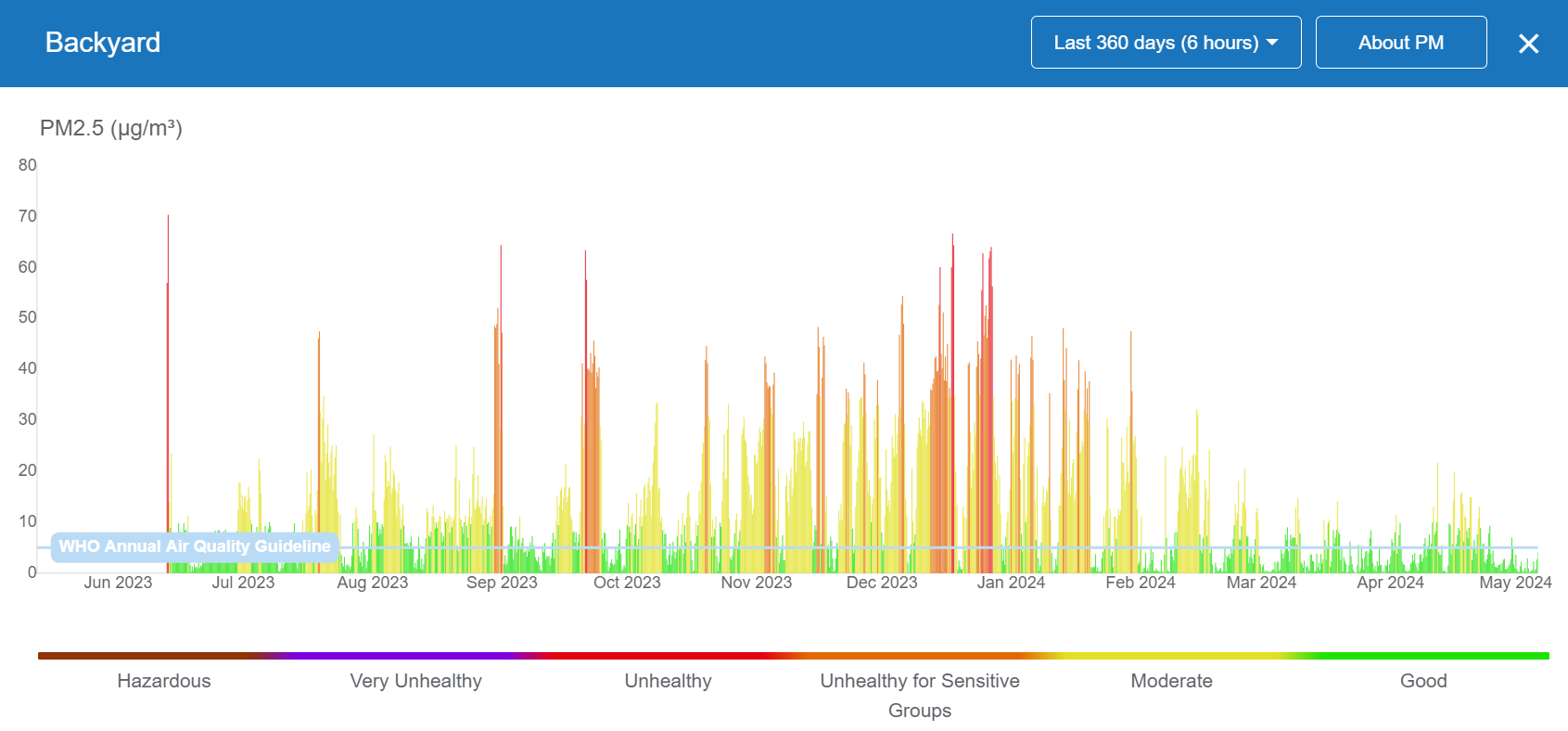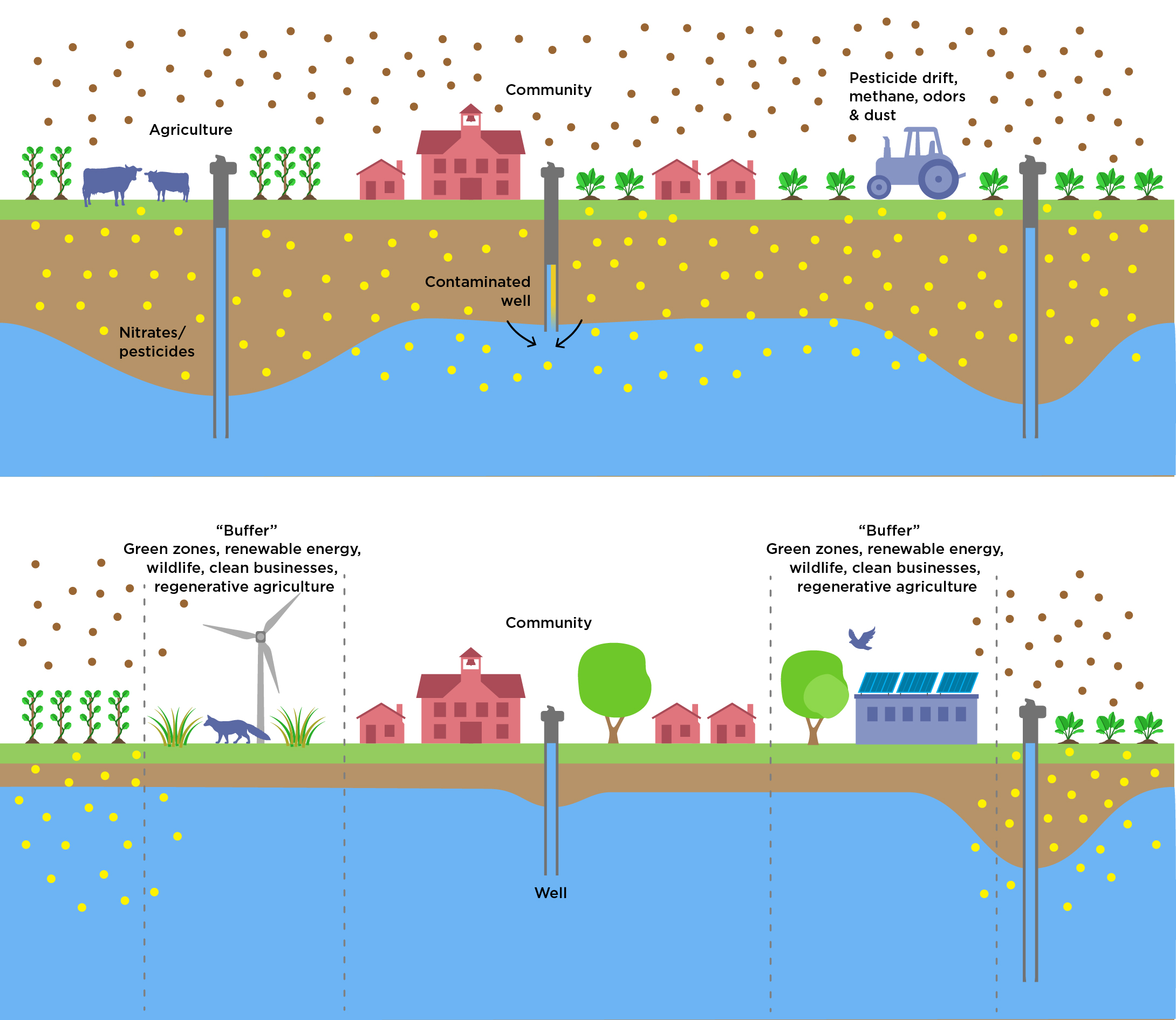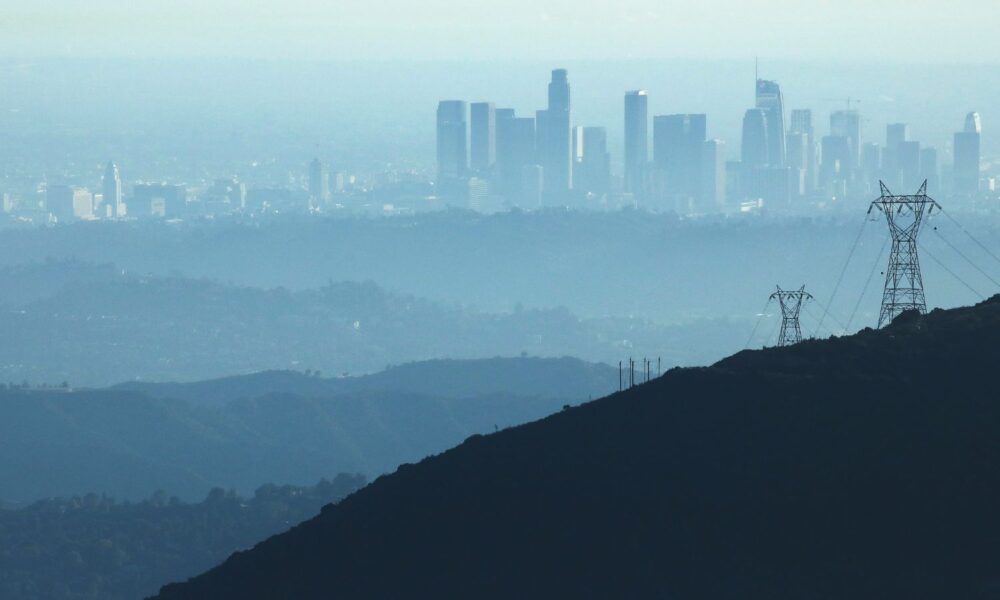I am into air quality.
Especially when it means I can breathe outside because there is no pesticide drift, wildfire smoke, vehicle exhaust, or pungent odors. However, the reasons why I am into air quality are a bit contradictory.
On the one hand, I am fascinated by air quality because I love working with sensors and monitoring equipment. I enjoy doing outreach and education about electronics with kids. I am also into open hardware and open data access. I have been collaborating for a few years with AirGradient and am part of a team of worldwide volunteer scientists who advocate for air quality justice.
And, importantly, I strongly believe in community-driven data collection to empower people with relevant information to advocate for a safe and healthy environment. It’s fun! You should try it! Check out the air quality data from my backyard in Merced, California, this past year:

The graph shows PM2.5 (particulate matter smaller than 2.5 micrometers). Spikes in PM2.5 make the air unhealthy. My best guess is that the fall spikes are dust from almond operations near my home, and the winter spikes come from a combination of sources, including burning fuel. The air in Merced is trapped by the classic temperature inversion of the San Joaquin Valley. In addition, Merced County applies more than 10 million pounds of pesticides per year that contribute to the area’s poor air quality.
On the other hand, I am scared about bad air quality. I live in the region with the worst air quality in the United States: the San Joaquin Valley in central California. But I consider myself lucky because I live in Merced, which has one of the best air qualities in the region, although best doesn’t mean it’s good.

Why do I choose to stay in a place with such bad air quality? I suppose I’m stubborn enough to believe that my presence here can make a difference. I moved to Merced in 2015 to study for my PhD, and I found a place I could call home. This is a diverse and wonderful community I now call my own. I became attached to the people and to the place. Maybe one day I will move out of the San Joaquin Valley, but not yet. I’m deeply committed to socioenvironmental justice and agricultural sustainability, and I want to help people who need it the most. Failure is not an option because I live here; I cannot just disconnect. This is more than just my job.
This is personal.
The 2024 State of the Air report
I work every day on topics related to air in my role as a Senior Climate Scientist at UCS, through my volunteer grassroots work, and because I want to be a well-informed resident in the San Joaquin Valley. So of course the American Lung Association’s yearly report, State of the Air (SOTA), published every year since 2000, is of professional and personal interest.
Since its inception, the report has effectively heightened the awareness of some hazardous air pollutants, and engaged the public, media, advocates, and policymakers in the ongoing fight against air pollution. The report aims to empower individuals like me to inform ourselves, our families, and our communities.
The air quality for this report was calculated using data reviewed by EPA from 2020, 2021, and 2022. That means it includes the extreme wildfires exacerbated by the fossil fuel industry that burned more than 4% of California in 2021 and 2022. You can find this year’s SOTA report, released last month, on the American Lung Association’s website, and you can compare it with 2023’s report, 2022’s, and all of the reports.
Bad news first: challenges with air quality persist
Unfortunately, there were no significant changes this year, and California and the southern San Joaquin Valley still have the worst air quality in the country by far.
This is not new. For the last several years, Bakersfield in Kern County, Visalia in Tulare County, the metropolitan area of Fresno, Kings, and Madera Counties, and Los Angeles have had the worst air quality in the United States out of more than 200 metropolitan areas nationally.
In the US, approximately 40% of the population, about 130 million people, live in places with failing grades for unhealthy levels of air quality.
Disparities in air quality disproportionately impact communities of color, highlighting systemic inequalities rather than individual choices. Across the county, people of color are 2.3 times more likely than white people to live in a county with failing grades in air quality.
This is not a new finding either. As UCS has been reporting for years, cars, trucks, and buses are a significant source of air pollution in California that disproportionately exposes Black, Latino, and Asian communities to higher levels of harmful pollution compared to majority white communities.
It is important to note that some extremely toxic air pollutants you may have heard about, such as ethylene oxide (EtO), are not included in the report. EtO is extremely difficult to monitor, yet very dangerous. You can inform yourself more in this UCS report.
One very important piece of information missing from the State of the Air report is air quality data for farmworker communities and other rural areas in the United States or California. The American Lung Association focuses only on metropolitan areas, and they use only official EPA air quality monitors. These monitors are very expensive and largely absent from small rural communities. All data used in the report must be reviewed by EPA, which makes the process slower.
In the San Joaquin Valley where I live, most rural communities are farmworker communities. Farmworkers are exposed to poor air quality both as outdoor workers and as residents inside homes that often are not properly insulated nor equipped with air conditioning to endure the scorching summer. While I think the American Lung Association report is a very important tool for millions of people in the US, we cannot forget that millions more live far from air quality monitors and may be breathing and living with poor air without knowing it. That is why community science for air quality monitoring in rural areas is extremely important to have everyone informed.
What pollutants are in the San Joaquin Valley’s (and California’s) air?
The American Lung Association’s State of the Air report measures three of the major types of pollutants in the San Joaquin Valley: long-term particle matter, short-term particle matter, and ozone.
Particle matter pollutants consist of extremely small solid and liquid particles in the air, originating from various sources like oil refineries and fossil fuel burning, fracking, transportation, conventional agriculture, wildfires, construction, and biomass burning (like heating with fireplaces). These particles are categorized by size. Coarse particles (PM10, that is particulate matter that is 10 micrometers or less) include dust and pollen, fine particles (PM2.5) come from burning fossil fuels and pesticide use, and ultrafine particles (PM0.1) come from reactions of industrial pollutants (nitrogen oxides and sulfur oxides) with sunlight and unfinished fuel combustion. Ultrafine particles can make the air look hazy even though individual particles are invisible to the naked eye. While the nose and throat mostly filter coarse particles trying to get into our bodies, fine and ultrafine particles can penetrate deep into the lungs and even enter the bloodstream. The negative effects include negative effects on cardiovascular and respiratory health, increased risk to babies and pregnant people, and increased risk of premature death in older adults. Even brief exposure to elevated levels of fine particles can increase the risk of heart attacks, strokes, and other cardiovascular events.
Ozone, too, poses significant risks to respiratory health. Ozone plays a dual role in our atmosphere. High up, it forms a protective layer that shields the Earth from ultraviolet rays. However, at ground level, where it can be inhaled, ozone becomes a key component of smog, a harmful mix of air pollutants. Ozone is formed when nitrogen oxides (NOx) and volatile organic compounds (VOCs) react in sunlight, and it is exacerbated under higher temperatures that make ozone pollution worse in the summer. In California, VOCs can come from fossil fuel industry, refineries, methane (especially in Los Angeles and southern San Joaquin Valley), and pesticides (in the San Joaquin Valley). NOx can come from vehicle pollution (Los Angeles, San Joaquin Valley, and the rest of California) and agricultural fertilizers (San Joaquin Valley). Short-term ozone exposure worsens asthma and chronic obstructive pulmonary disease, increases pneumonia risk, and impairs lung function. Long-term exposure can lead to asthma development, chronic obstructive pulmonary disease, and systemic health issues, including premature death.
As a reminder, California has about one quarter of a million oil wells: some small communities in Kern County, at the southern end of the San Joaquin Valley, are surrounded by thousands of wells, and people in L.A., Bakersfield, and other cities are familiar with oil wells in their metropolitan areas. For example, there are 1,700 oil wells inside the small rural community of Derby Acres and 9,500 within one mile. Inside the relatively large city of Bakersfield (population 410,000), also in Kern County, there are around 2,000 wells, and within one mile of the city there are more than 9,000. The metropolitan area of Bakersfield is and has been for several years the most polluted metropolitan area in the United States by short-term and year-round particulate matter, and ranks in third position for ozone pollution.

There’s good news: we’re working on solutions
The air quality in the San Joaquin Valley is poor, and we don’t even know how bad it actually is in the valley’s rural areas. But the good news is there are plenty of people doing something about it because we live here and we care.
For example, several groups like Central California Asthma Collaborative, Central California Environmental Justice Network, and the SocioEnvironmental and Education Network are installing accurate and affordable air quality monitors in many rural communities to raise awareness of air quality injustice and conduct outreach about its health impacts.
Another example is that of researchers at UC Merced who are trying a new generation of AI models to better estimate air quality in rural areas. Data collected with low-cost air quality monitors by community members can be used to inform their communities and support local leaders to make real-time decisions in response to air quality changes. Data can also be used to improve the accuracy of air quality models, which in turn will give even better information to communities.
The news from the SOTA report may be dire, but what gives me hope (besides phasing out fossil fuels) is a solution that I and many colleagues here in the San Joaquin Valley are actively working on: cropland repurposing. It’s a powerful solution that I blog about often (here, here, and here).
Cropland repurposing is a viable solution to address water scarcity and water quality; and, the good news is it is also a solution to improve air quality. Cropland repurposing alongside sustainable agriculture that prioritizes healthy soil, limited to no use of pesticides, and reduced application of toxic fertilizers can improve air quality in places like the San Joaquin Valley. Here we will need to repurpose probably more than one million acres of crops over the next decades.
If we do it right, cropland repurposing can dramatically improve the quality of life in disadvantaged communities and increase economic and agronomic resilience for farmers while achieving sustainable water use and fostering environmental health.
In rural areas, a one-mile revitalization zone around the smallest 123 agricultural disadvantaged communities of the San Joaquin Valley could decrease water usage by 1.45 million acre-feet, pesticide usage by 11 million pounds, nitrate leaching to aquifers by 193 million pounds, and CO2 emissions by 1.85 million metric tons. This was the conclusion of a peer-reviewed study I was involved in.
But reimagining sustainable agriculture in California can also help the metropolitan areas reported on by the American Lung Association’s State of the Air report.
As a reminder, the worst air quality in the United States is in Kern, Tulare, and Fresno counties, and by far these three are the counties with the highest pesticide application in California. I don’t know if better agricultural practices can give a passing grade to our San Joaquin Valley cities because fossil fuel-related pollution is still very bad in those areas. But ending our reliance on fossil fuels combined with better agricultural practices can dramatically increase air quality in California for all of us.

The way forward
California’s air quality issues stem from a combination of its geography, climate, and anthropogenic factors. California’s beautiful topography, with its valleys and mountains, can make the air stagnant and trap air pollutants, leading to the accumulation of pollution in certain areas like the San Joaquin Valley or Los Angeles. We cannot change the topography.
Climatically and meteorologically, California has temperature inversions, where a layer of warm air traps cooler air near the ground, preventing pollutants from dispersing into the atmosphere. Again, this is particularly common in the Central Valley and in Los Angeles. Additionally, wildfires, exacerbated by climate change and drought conditions, release large amounts of smoke and particulate matter into the air, further worsening air quality.
While we can do a better job managing our forests to prevent wildfires, we cannot modify California’s meteorological characteristics. But we can change the anthropogenic factors that lead California to having the worst air quality in the United States.
We need to do more to improve air quality in both urban and rural areas and to inform people about it. We need to care about how public policies shape Californians’ health. We need to demand better, cleaner alternatives for energy, transportation, and agriculture. We need to reverse climate change.
Of course, I know this is easy to say… but if we act together, it can also be feasible to do!
In California cities, to improve our air quality and our well-being, we must end the reliance on fossil fuels, promote clean transportation, and enhance greener urban planning.
In California rural and agricultural areas, in addition to the above, we need to learn from the past and become sustainable. Cropland repurposing is an opportunity to improve everyone’s quality of life, bring economic and environmental sustainability to farmers and rural communities, and improve our air quality by drastically reducing the reliance on pesticides and fertilizers and by stopping inadequate agronomic practices that release polluting dust.
We are at a critical moment in California with a once-in-a-generation funding opportunity to correct injustices and improve climate resilience in the United States thanks to funds from the Inflation Reduction Act and Infrastructure Investment and Jobs Act. If California is going to continue to lead in environmental protection, agriculture, and technology, and make its air cleaner, then our elected leaders must incentivize more than ever the cleanest energy and transportation, the most sustainable agricultural practices, and the most equitable and environmentally-friendly economic growth.
Our noses, throats, hearts, and lungs deserve it.

